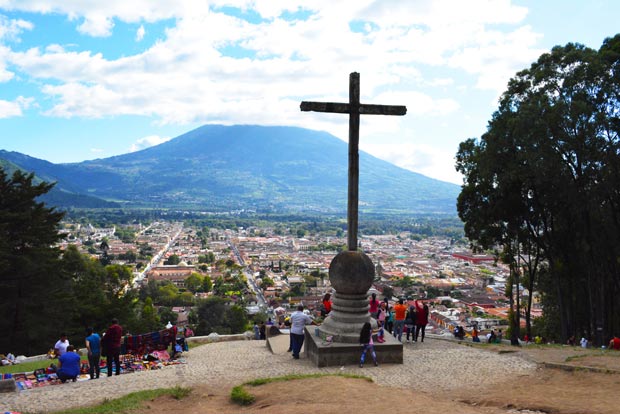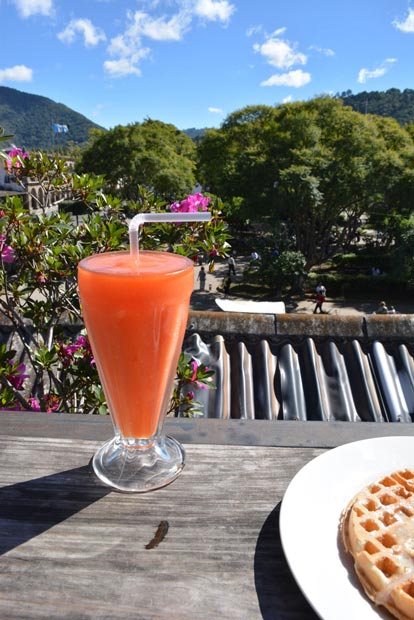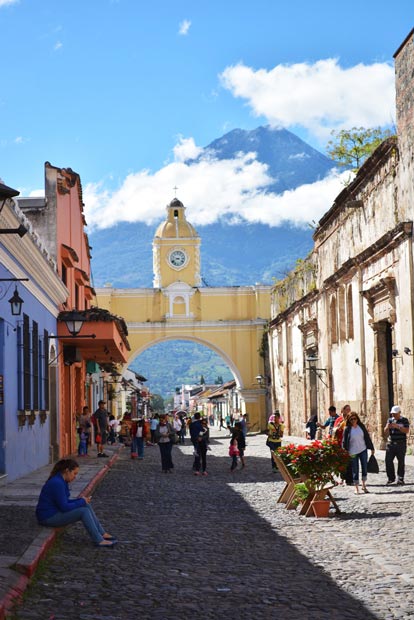Rising from the ruins, discover the wonders of Antigua
If you’re after a feast for the eyes, then head to Antigua in Guatemala. Antigua is full of colour, beautiful buildings in the Spanish Baroque style, and surrounded by volcanoes – some even active.
Antigua was once the capital of Guatemala and dates back to the 1500s. It is now a UNESCO World Heritage Site. Guatemala’s capital was relocated from Antigua to what is now present day Guatemala City after a severe earthquake in 1773. Many buildings have been preserved as ruins following this earthquake, making for fascinating sightseeing. I spent hours just wandering the cobblestone streets of Antigua – taking in the colours, ruined buildings, and standing in awe of the nearby volcanoes.
Antigua is set in a square grid pattern and is ringed by volcanoes – the most iconic is Volcan de Agua or volcano of water. Antigua is easy to get around on foot. It’s a small city, and you don’t need a map to find your way around. For a great view of Antigua and the surrounding volcanoes, head up the hill to Cerro de la Cruz (Hill of the Cross). You can see the cross from most parts of Antigua, and it’s easy to get there.
You can take a tuk-tuk up, or it’s a short 20-minute walk from the centre of town. The steepest part of the walk is up the trail to the cross which you can only do on foot. There’s a few steps up but should just take you between five to 10 minutes. The views are worth it. You can even see Volcano de Fuego (Volcano of Fire) billowing steam and gas from the cross.

Back in town, check out the ruins of a convent behind San Francisco Church. An earthquake severely damaged the convent, but you can go through most parts of the ruin.
San Jose Church, the Church and Convent of Santa Clara and the El Carmen Church are also worth a look. You can go inside the San Jose and Santa Clara churches. The El Carmen church looks like it’s permanently closed to the public but there’s a market held here on the weekends.

Convent of the Capuchinas is located on the corner of 2a Calle Oriente and is worth the small entry fee. The convent was abandoned after the 1773 earthquake but is under restoration. I found this building fascinating.

On entry, make sure you head up the stairs to the walkway to overlook a sunny courtyard, and also seek out the monk’s cells, set in a circle. The convent is bounded by overhanging bougainvillaea vines and grassy areas, with some visitors taking the opportunity to sit down for a picnic during their visit.
For a meal with a view, head along to the La Casaca Café. It’s situated across from Plaza Mayor and has a rooftop terrace. It’s a relaxing spot to soak up some sun, get a view of the plaza and take in the bustling street life. Try the papaya smoothie – trust me!

While it’s a bit of a gauntlet walking through Plaza Mayor and you’ll be approached by many people selling their wares, the mermaid fountain in the middle of the plaza is worth a quick look. Another good spot for breakfast is Panaderia Santa Clara. Their meals are enormous and well-priced. They also have a sun-baked terrace that looks out to Volcan de Agua. If you are looking for the iconic yellow arch with the volcano in the background that features in most pictures you’ll see of Antigua? You’ll find the Santa Catalina arch on 5a Avenida Norte.

Try and head to the arch early as it gets busy in the avenue, especially in the afternoon. If you’re brave enough to try the street food, you’ll have plenty of options with fruit such as papaya and pineapple on offer, as well as hot food such as chicken or tortilla dishes in the park opposite the arch.
This street seems to be the main tourist strip of Antigua with plenty of restaurants, a couple of agents offering short tours, and lots of Guatemalans selling their handmade wares on the street such as scarves, beanies and toys. There are also a couple of markets that go deep inside buildings full of colourful items.
You can also use Antigua as a base to explore nearby parts of Guatemala. There’s a couple of travel agents in the centre offering tours to Tikal Mayan ruins and Lake Atitlan, or hikes up nearby volcanoes such as Pacaya Volcano. To get to Antigua, you will need to fly into Guatemala City unless you’re coming by bus from Mexico and visiting the Guatemalan Mayan ruins such as Flores and Tikal. From Guatemala City Airport, take the Antigua Shuttle. Allow up to two hours for the journey depending on traffic. Traffic can be hefty in Guatemala City.
Things you should know:
- Many places in Guatemala only accept cash, not cards – even hotels. It’s best to carry some quetzales on you, and US dollars can also be used at some places. There’s several money exchange stands at Guatemala City Airport.
- A little bit of Spanish will get you a long way in Guatemala. It will be helpful for learning the basics such as ordering food and buying entry tickets.
- Avoid drinking the tap water in Guatemala. Buy bottled water. Don’t even brush your teeth with the tap water. (Trust me, I learnt this the hard way.)
- Be careful with the street food. If you have a weak stomach, avoid it. The general rule of thumb is don’t eat any fruit or vegetables that can’t be peeled.
- Antigua is a reasonably safe city, but females will get some male attention – mainly just looks and wolf whistles. But if you’re going out at night, try and head out with someone. It’s also best to dress conservatively.
Lisa Owen is a pint-sized Australian following her dreams to travel to as many places as she can, and loves to share her photography, travel hacks, hiking adventures, and food discoveries along the way. At last count, she has travelled to more than 40 countries in between working in public relations and discovering hidden gems in Australia's great outdoors.
Instagram: @_thelittleadventurer Facebook: The Little Adventurer Australia
The views, opinions and positions expressed by the author and those providing comments are theirs alone and are meant as travel inspiration only. They do not reflect the opinions of Cover-More Insurance. You should always read the PDS available from your travel insurance provider to understand the limits, exclusions and conditions of your policy and to ensure any activities you undertake are covered by your policy.